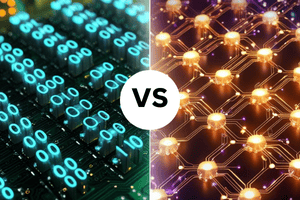NIST Post-Quantum Cryptography Standardization Project
Preparing for the Quantum Era: The Race to Secure Cryptography
Quantum computing is rapidly transitioning from theoretical research to practical implementation. What was once confined to physics labs is now emerging as a disruptive force in both industry and national security. Institutions like MIT, and global tech giants such as IBM, Microsoft, Google, and Intel, have already delivered working quantum processors capable of demonstrating early quantum advantage for specific tasks. While today’s systems are not yet capable of breaking cryptographic systems, progress is accelerating at a pace that security experts can no longer ignore.
The core concern is this: once large-scale, fault-tolerant quantum computers become a reality, they will be capable of executing algorithms—like Shor’s Algorithm—that can efficiently break the mathematical foundations of nearly all public-key cryptographic systems in use today. This includes widely deployed standards such as RSA, Diffie-Hellman (DH), and Elliptic Curve Cryptography (ECC), which currently secure everything from online banking and email to software updates and military communications.
The Growing Threat of Quantum Attacks
While current quantum computers have not yet reached the scale needed to compromise these systems, the threat is not speculative. Many experts believe that a cryptographically relevant quantum computer (CRQC), one capable of breaking RSA-2048 or ECC-256, could emerge within 10 to 15 years, or even sooner if breakthroughs in error correction or qubit scaling occur.
Moreover, threat actors are already preparing. The “harvest now, decrypt later” strategy is being employed by some nation-state adversaries: they intercept and store encrypted data today with the intention of decrypting it in the future once quantum capabilities mature. Sensitive information with long-term value, such as state secrets, intellectual property, or health data, could be at risk even if it remains encrypted for years.
NIST’s Response: A New Era of Post-Quantum Cryptography
To address this looming crisis, the National Institute of Standards and Technology (NIST) launched a formal effort in 2016 to solicit, evaluate, and standardize quantum-resistant public key cryptographic algorithms. This effort, the Post-Quantum Cryptography (PQC) Standardization Project, brought together researchers from around the world to submit and test new algorithms that could replace RSA and ECC in a post-quantum world.
After several years of rigorous cryptanalysis, NIST announced its first set of finalists and selected algorithms in July 2022. These include:
- CRYSTALS-Kyber for key encapsulation (encryption and key exchange)
- CRYSTALS-Dilithium, FALCON, and SPHINCS+ for digital signatures
These algorithms were chosen based on their resistance to both classical and quantum attacks, their performance, and their suitability for a wide range of hardware and software platforms. NIST released these standards in August 2024, giving the industry a roadmap for secure communication in the quantum era.
The Need for Immediate Action
Even with NIST’s leadership, transitioning global infrastructure to quantum-safe cryptography will take years, if not decades. Organizations must begin preparing now:
- Assess cryptographic exposure: Identify where RSA, ECC, or DH are used across systems, devices, and applications.
- Implement crypto agility: Design systems that can easily switch to new algorithms without complete redesigns.
- Monitor evolving standards: Stay aligned with NIST recommendations and emerging international standards.
- Deploy hybrid approaches: Use classical and post-quantum algorithms together during the transition period.
- Consider constrained environments: Adopt lightweight post-quantum cryptography solutions, especially for IoT and embedded devices that have limited processing and memory resources.
A Turning Point for Cybersecurity
The quantum threat is not just a technical challenge, it’s a strategic imperative. Enterprises, governments, and critical infrastructure providers must view quantum readiness as part of their long-term security planning. The stakes are high: failure to act now could result in encrypted data being compromised in the not-too-distant future.
Fortunately, the cybersecurity community is responding. Through NIST’s leadership, academic innovation, and commercial development, including contributions from organizations like Veridify Security, which offer efficient quantum-resistant cryptographic solutions for resource-constrained environments, the foundation for a post-quantum world is already being laid.
Conclusion
Quantum computing will revolutionize many aspects of science and technology, but it also presents a clear and present danger to today’s digital security systems. As the industry pivots toward a quantum-safe future, organizations have both the tools and the guidance they need to prepare.
With NIST’s forthcoming standards and an expanding ecosystem of quantum-resistant cryptographic tools, the race is on, not just to build quantum computers, but to secure our digital world against them.
[Post-Quantum Cryptography Standardization Project]



